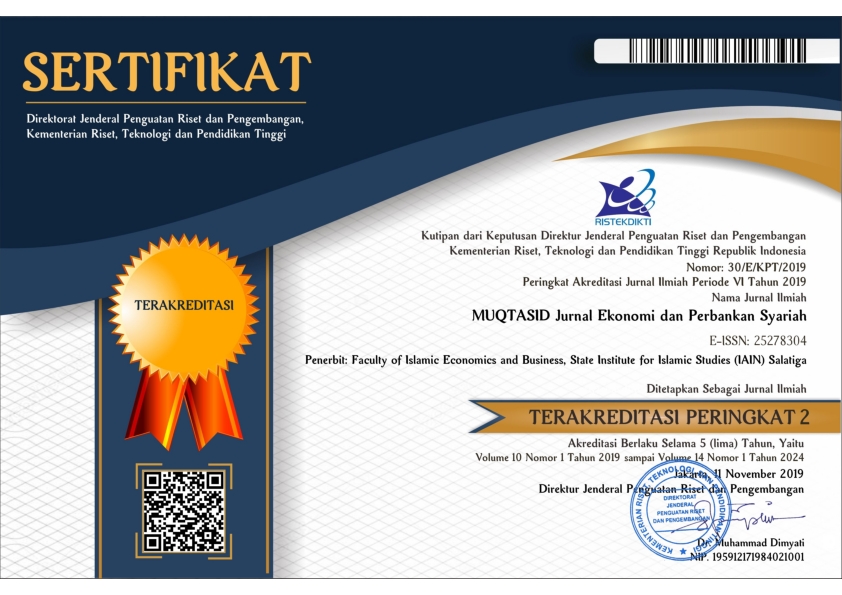The Role of Equity Financing on the Profitability of Indonesian Islamic Banks
Abstract
Islamic banks provide financing in the form of equity financing and non-equity financing. Equity financing is profit-loss sharing financing which is the main core of Islamic bank business consisting of Mudharabah and Musyarakah. This paper examines the extent to which equity financing affects the profitability of Islamic banks in Indonesia with the control variables consisting of bank-specific variables such as capital adequacy ratio, cost-income ratio, non-performing financing, and macroeconomic conditions such as domestic output, exchange rate. This study employs aggregate data of Islamic banks from January 2010 to December 2019. The estimation method is the Autoregressive distributed lag (ARDL) model. The results prove evidence of the long-run relationship between the dependent and
independent variables. The results show that total equity financing increases Islamic banks' profitability in Indonesia, but only Musyarakah financing significantly boosts profitability. Furthermore, the bank-specific variables affecting profits are capital, efficiency, and nonperforming financing. High capital adequacy ratio (CAR) reduces profit and inefficient Islamic banks and non-performing financing lower profit. Evidence also highlights that worse economic conditions through the economic downturn and sharp depreciation obviously lower the profitability of Islamic banks. These results imply that Islamic banks must capitalize on Musyarakah financing to support the performance of Islamic banks.
Keywords
Full Text:
PDFReferences
Ahamed, M. M. (2017). Asset Quality, Non-interest Income, and Bank Profitability: Evidence from Indian banks. Economic Modelling, 63, 114. https://doi.org/10.1016/j.econmod.2017.01.016.
Aminah, Soewito, Erina, N., Khairudin, & Damayanti, T. (2019). Financial Performance and Market Share in Indonesia Islamic Banking: Stakeholder Theory Perspective. International Journal of Scientific and Technology Research, 8(1), 1418.
Azmat, S., Skully, M., & Brown, K. (2015). Can Islamic Banking Ever Become Islamic? Pacific Basin Finance Journal, 34, 253272. https://doi.org/10.1016/j.pacfin.2015.03.001.
Chen, N., Liang, H. Y., & Yu, M. T. (2018). Asset Diversification and Bank Performance: Evidence from Three Asian Countries with a Dual Banking System. Pacific Basin Finance Journal, 52(February), 4053. https://doi.org/10.1016/j.pacfin.2018.02.007.
Čihák, M., & Hesse, H. (2010). Islamic Banks and Financial Stability: An Empirical Analysis. Journal of Financial Services Research, 38(2), 95113. https://doi.org/10.1007/s10693-010-0089-0.
Hamid, F. S. (2017). The Effect of Market Structure on Banks Profitability and Stability: Evidence from ASEAN-5 Countries. International Economic Journal, 31(4), 578598. https://doi.org/10.1080/10168737.2017.1408668.
Hosen, M. N., & Rahmawati, R. (2016). Efficiency and Profitability on Indonesian Islamic Banking Industry. Al-Iqtishad: Journal of Islamic Economics, 8(1), 3348. https://doi.org/10.15408/aiq.v8i1.2507.
Ibrahim, M. H., & Rizvi, S. A. R. (2017). Do We Need Bigger Islamic Banks? An Assessment of Bank Stability. Journal of Multinational Financial Management, 40, 7791. https://doi.org/10.1016/j.mulfin.2017.05.002
Muhammad, R., Suluki, A., & Nugraheni, P. (2020). Internal Factors and Non-Performing Financing in Indonesian Islamic Rural Banks. Cogent Business and Management, 7(1), 112. https://doi.org/10.1080/23311975.2020.1823583.
Pesaran, M. H., Shin, Y., & Smith, R. J. (2001). Bounds Testing Approaches to the Analysis of Level Relationships. Journal of Applied Econometrics, 16(3), 289326. https://doi.org/10.1002/jae.616.
Risfandy, T. (2018). Equity Financing and Islamic Banks Profitability: Evidence from the Biggest Muslim Country. Jurnal Keuangan Dan Perbankan, 22(3), 496505. https://doi.org/10.26905/jkdp.v22i3.2150.
Risfandy, T., Harahap, B., Hakim, A. R., Sutaryo, S., Nugroho, L. I., & Trinugroho, I. (2020). Equity Financing at Islamic Banks: Do Competition and Bank Fundamentals Matter? Emerging Markets Finance and Trade, 56(2), 314328. https://doi.org/10.1080/ 1540496X.2018.1553160.
Setiawan, C., & Bagaskara, B. (2016). Non-Performing Financing (NPF) and Cost Efficiency of Islamic Banks in Indonesia Period 2012Q1 to 2015Q2. Journal of Emerging Issue in Economics, Finance and Banking, 5(1), 18161831.
Sriyana, J. (2015). Islamic Banks Profitability amid the Competitive Financing in Indonesia. International Journal of Applied Business and Economic Research, 13(4), 16951710.
Sutrisno, & Widarjono, A. (2018). Maqasid Sharia Index, Banking Risk and Performance Cases in Indonesian Islamic Banks. Asian Economic and Financial Review, 8(9), 1175-1184. https://doi.org/10.18488/journal.aefr.2018.89.1175.1184.
Trinugroho, I., Agusman, A., & Tarazi, A. (2014). Why Have Bank Interest Margins been so High in Indonesia since the 1997/1998 Financial Crisis? Research in International Business and Finance, 32, 139158. https://doi.org/10.1016/j.ribaf.2014.04.001.
Trinugroho, I., Risfandy, T., & Ariefianto, M. D. (2018). Competition, Diversification, and Bank Margins: Evidence from Indonesian Islamic Rural Banks. Borsa Istanbul Review, 18(4), 349358. https://doi.org/10.1016/j.bir.2018.07.006.
Trinugroho, I., Risfandy, T., Ariefianto, M. D., Prabowo, M. A., Purnomo, H., & Purwaningsih, Y. (2017). Does Religiosity Matter for Islamic Banks Performance? Evidence from Indonesia. International Journal of Economics and Management, 11(2), 419435.
Warninda, T. D. (2014). Islamic Rural Bank Profitability: Evidence from Indonesia. Journal of Islamic Economics, Banking and Finance, 3, 109122.
Warninda, T. D., Ekaputra, I. A., & Rokhim, R. (2019). Do Mudarabah and Musharakah Financing Impact Islamic Bank Credit Risk Differently? Research in International Business and Finance, 49, 166175. https://doi.org/10.1016/j.ribaf.2019.03.002.
Widarjono, A. (2018). Estimating Profitability of Islamic Banking in Indonesia. Jurnal Keuangan Dan Perbankan, 22(3), 568579. https://doi.org/10.26905/jkdp.v22i3.2197.
Widarjono, A. (2020). Does the Volatility of Macroeconomic Variables Depress The Profitability of Islamic Banking? Jejak, 13(1), 3042. https://doi.org/10.15294/jejak.v13i1.19460.
Widarjono, A., & Anto, M. B. H. (2020). Does Market Structure Matter for Islamic Rural Banks Profitability? Jurnal Keuangan Dan Perbankan, 24(4),393406.https://doi.org/10.26905/jkdp.v24i4.4810.
Widarjono, A., Anto, M. B. H., & Fakhrunnas, F. (2020). Financing Risk in Indonesian Islamic Rural Banks: Do Financing Products Matter ? The Journal of Asian Finance, Economics and Business, 7(9), 305314. https://doi.org/10.13106/jafeb.2020.vol7.no9.305.
Widarjono, A., Anto, M. B. H., & Fakhrunnas, F. (2021). Is Islamic Bank More Stable Than Conventional Bank ? Evidence From Islamic Rural Banks in Indonesia. International Journal of Financial Research, 12(2), 294307. https://doi.org/10.5430/ijfr.v12n2p294.
Widarjono, A., Mifrahi, M. N., & Perdana, A. R. A. (2020). Determinants of Indonesian Islamic Rural Banks Profitability: Collusive or Non- Collusive Behavior ? The Journal of Asian Finance, Economics and Business, 7(11), 657668. https://doi.org/ 10.13106/jafeb.2020.vol7.no11.657.
Widarjono, A., & Rudatin, A. (2021). Financing Diversification and Indonesian Islamic Banks Non-Performing Financing. Jurnal Ekonomi & Keuangan Islam, 7(1), 4558.
DOI: https://doi.org/10.18326/muqtasid.v12i2.129-143
Refbacks
- There are currently no refbacks.
License URL: http://creativecommons.org/licenses/by-sa/4.0/

MUQTASID by http://muqtasid.iainsalatiga.ac.id/ is licensed under a Creative Commons Attribution-ShareAlike 4.0 International License.
MUQTASID Jurnal Ekonomi dan Perbankan Syariah UIN SALATIGA p-ISSN: 2087-7013, e-ISSN: 2527-8304




